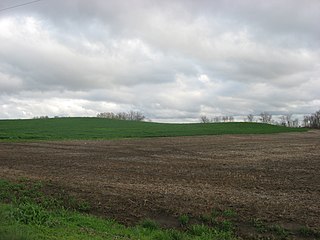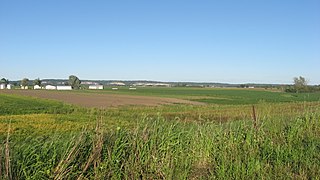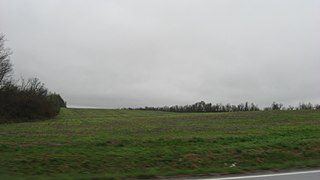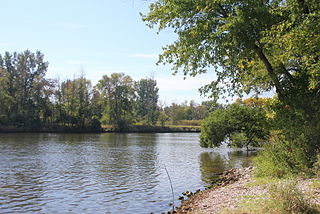
Starved Rock State Park is a state park in the U.S. state of Illinois, characterized by the many canyons within its 2,630 acres (1,064 ha). Located just southeast of the village of Utica, in Deer Park Township, LaSalle County, Illinois, along the south bank of the Illinois River, the park hosts over two million visitors annually, the most for any Illinois state park.

Etowah Indian Mounds (9BR1) are a 54-acre (220,000 m2) archaeological site in Bartow County, Georgia, south of Cartersville. Built and occupied in three phases, from 1000–1550 CE, the prehistoric site is located on the north shore of the Etowah River.

The Grand Village of the Illinois, also called Old Kaskaskia Village, is a site significant for being the best documented historic Native American village in the Illinois River valley. It was a large agricultural and trading village of Native Americans of the Illinois confederacy, located on the north bank of the Illinois River near the present town of Utica, Illinois. French explorers Louis Joliet and Father Jacques Marquette came across it in 1673. The Kaskaskia, a tribe of the Illiniwek people lived in the village. It grew rapidly after a French mission and fur trading post were established there in 1675, to a population of about 6,000 people in about 460 houses. Around 1691 the Kaskaskia and other Illiniwek moved further south, abandoning the site due to pressure from an Iroquois invasion from the northeast.
The Orendorf Site is a prehistoric archaeological site located near the city of Canton, Fulton County, Illinois. The site includes four distinct areas of Middle Mississippian settlement; the settlement area was one of seven major sites in the Spoon River tradition. The four settlement sites within the larger site came as the result of a single village relocating multiple times; this movement became useful to archaeologists, as artifacts from different periods are spread out rather than mixed together at a single site. The settlement functioned as a regional center within the Spoon River culture, making it a hub in its hierarchal political organization and part of many important trade routes. Trade and migration linked the settlement to the large Mississippian city of Cahokia; while the settlement's culture had much in common with Cahokian culture, it was also a distinct regional culture in its own right.

Pueblo Grande Ruin and Irrigation Sites are pre-Columbian archaeological sites and ruins, located in Phoenix, Arizona. They include a prehistoric platform mound and irrigation canals. The City of Phoenix manages these resources as the S’edav Va’aki Museum.

The Modoc Rock Shelter is a rock shelter or overhang located beneath the sandstone bluffs that form the eastern border of the Mississippi River floodplain at which Native American peoples lived for thousands of years. This site is significant for its archaeological evidence of thousands of years of human habitation during the Archaic period in the Eastern United States. It is located on the northeastern side of County Road 7 southeast of Prairie du Rocher in Randolph County, Illinois, United States. It was declared a National Historic Landmark in 1961.

Albany Mounds State Historic Site, also known as Albany Mounds Site, is a historic site operated by the Illinois Historic Preservation Agency. It spans over 205 acres of land near the Mississippi river at the northwest edge of the state of Illinois in the United States. In 1974, the site was added to the National Register of Historic Places list. The historical site is under the provision of the Illinois Historic Preservation Agency, a governmental agency founded in 1985 for the maintaining of historical sites within the state. In the 1990s, the site underwent a restoration project that aimed to return its appearance to its original condition.

The Sommerheim Park Archaeological District includes a group of six archaeological sites west of Erie, Pennsylvania in the United States. The sites are in Sommerheim Park, one of the few undeveloped areas of the Lake Erie shoreline, in Millcreek Township. This district has been listed on the National Register of Historic Places. This is one of the leading archaeological sites in the Erie area and along the southern shoreline of Lake Erie, due to the amount of artifacts and the lack of disturbance on the site.

The Summer Island site, designated 20DE4, is an archaeological site located on the northwest side of Summer Island, in Delta County, Michigan. It is classified as a stratified, multi-component site with Middle Woodland, Upper Mississippian and Early Historic/Protohistoric occupations. It was listed on the National Register of Historic Places in 1971.

The Dumaw Creek Site is an archaeological site designated 20OA5, located along Dumaw Creek northeast of Pentwater, Michigan, that was the location of a 17th-century village and cemetery. It is one of the youngest pre-historic sites in Michigan, dating to the terminal Late Woodland Period just prior to European contact. It was listed on the National Register of Historic Places in 1972.

The Ware Mounds and Village Site (11U31), also known as the Running Lake Site, located west of Ware, Illinois, is an archaeological site comprising three platform mounds and a 160-acre (65 ha) village site. The site was inhabited by the Late Woodland and Mississippian cultures from c. 800 to c. 1300. The village is one of the only Mississippian villages known to have existed in the Mississippi River valley in Southern Illinois. As the village was located near two major sources of chert, which Mississippian cultures used to make agricultural tools, it was likely a trading center for the mineral.

The Kolmer Site is an archaeological site in the far southwest of the U.S. state of Illinois. Located near Kaskaskia and Prairie du Rocher in western Randolph County, it lies at the site of an early historic Indian village from the French period. Because it occupies a critical chronological and cultural position, it has been given national recognition as a historic site.

The Orr-Herl Mound and Village Site is an archaeological site located along the Ohio River in Hardin County, Illinois, United States. The site consists of a mound, which includes a sizable midden, and the remains of a village. The village was inhabited from roughly 900 to 1500 AD by Mississippian peoples. The site was an important source of fluorspar, which Mississippian peoples used for carvings and beads. The village was likely a manufacturing site for fluorspar items, which were then traded to other villages; this theory is supported by fluorspar artifacts recovered from the Kincaid Site, a Mississippian chiefdom center on the Ohio River in Illinois.

The Spikebuck Town Mound and Village Site is a prehistoric and historic archaeological site on Town Creek near its confluence with the Hiwassee River within the boundaries of present-day Hayesville, North Carolina. The site encompasses the former area of the Cherokee village of Quanassee and associated farmsteads. The village was centered on what is known as Spikebuck Mound, an earthwork platform mound, likely built about 1,000 CE by ancestral indigenous peoples during the South Appalachian Mississippian culture period.
The Marshall Site is an archaeological site in the Marshall State Fish and Wildlife Area in Marshall County, Illinois, across the Illinois River from Chillicothe. The site consists of a boulder carved with five petroglyphs. The petroglyphs, which archaeologists believe were created by Native Americans between 1673 and 1835, depict three anthropomorphs, an L-shaped figure, and a possible avimorph. The site was added to the National Register of Historic Places on August 25, 2014.

The Sleeth Site is an archaeological site located near Liverpool in Fulton County, Illinois. The side encompasses a 10-acre (4.0 ha) village area including a sizable midden. The site was occupied by people of the Spoon River Culture, a local culture within the Middle Mississippian culture; it is the only known site within the Sleeth Phase of the culture and has been dated to 1500 A.D. Cultural artifacts recovered from the site include many projectile points and pottery shards from jars, plates, and bowls.

The Moccasin Bluff site is an archaeological site located along the Red Bud Trail and the St. Joseph River north of Buchanan, Michigan. It was listed on the National Register of Historic Places in 1977, and has been classified as a multi-component prehistoric site with the major component dating to the Late Woodland/Upper Mississippian period.

The Battle Point Site, also designated 20OT50, is an archaeological site located on Battle Point, along the Grand River in Crockery Township, Ottawa County, Michigan. It was listed on the National Register of Historic Places in 1973.
The Bell site is located on the south side of Big Lake Butte des Morts in Winnebago County, Wisconsin, about 52 miles southeast of Green Bay. The site is classified as an early Historic village of the Meskwaki (Fox) people.
The Rock Island II Site is an archaeological site located on the south side of Rock Island, in Door County, Wisconsin, United States, at the mouth of Green Bay, within the boundaries of Rock Island State Park. It is classified as an Early Historic site with occupations by the Potawatomi, Huron, Petun, Ottawa and Wyandot tribes. It was listed on the National Register of Historic Places in 1972, and was designated a National Historic Landmark in 2023. It is one of the best-preserved sites documenting early Native-European contacts in the Great Lakes region.
















